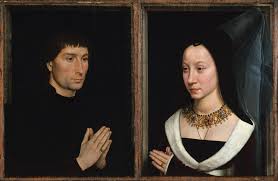Tommaso di Folco Portinari (1428–1501); Maria Portinari (Maria Maddalena Baroncelli, born 1456).
By Hans Memling
Tommaso di Folco Portinari is the left portrait while Maria Portinari is portrayed on the right. Both appear to be serious, wearing black and white, and holding their hands in a prayer position. Their positioning also makes it apparent they could be praying towards each-other. Maria has a large necklace, no makeup, and a long hat while Tommaso has a pinky ring and black clothes. Since they both have the same last name I assume they are either siblings or married.
Tommaso was an Italian banker for Bruges. He worked there for over 25 years. He became general manager and shareholder in his 40’s. Portinari used his position to make very large and extremely risky unsecured loans to Charles the Bold loans which were never repaid and cost the bank heavily.[1] Only a small portion was paid off. Tomasso had his painting made to compare himself to his predecessor.
Maria was painted before her wedding day. She married Tomasso. She is known to be 14 years old at the time of this painting. She is wearing fifteenth century fashion of
[1] https://en.wikipedia.org/wiki/Tommaso_Portinari
a black hennin, transparent veil, and necklace. Tomasso commisioined this work piece. Many believe Marias necklace was put on to copy Margaret of Yorks wedding necklace. She wore it to promote wealth.
They originally formed a triptych with a central devotional image of the Virgin and Child.[1] Memling was a leading artist at the time of the commission. It was in art that the spirit of the Renaissance achieved its sharpest formulation. Art came to be seen as a branch of knowledge, valuable in its own right and capable of providing man with images of God and his creations as well as with insights into man’s position in the universe.[2] Men believed woman were only created by God for the purpose of serving them. Marriage was also not built on love during this time. They could be for many reasons like social gaining.
[1] The Metropolitan Museum of Art
[2] Britannica.com
